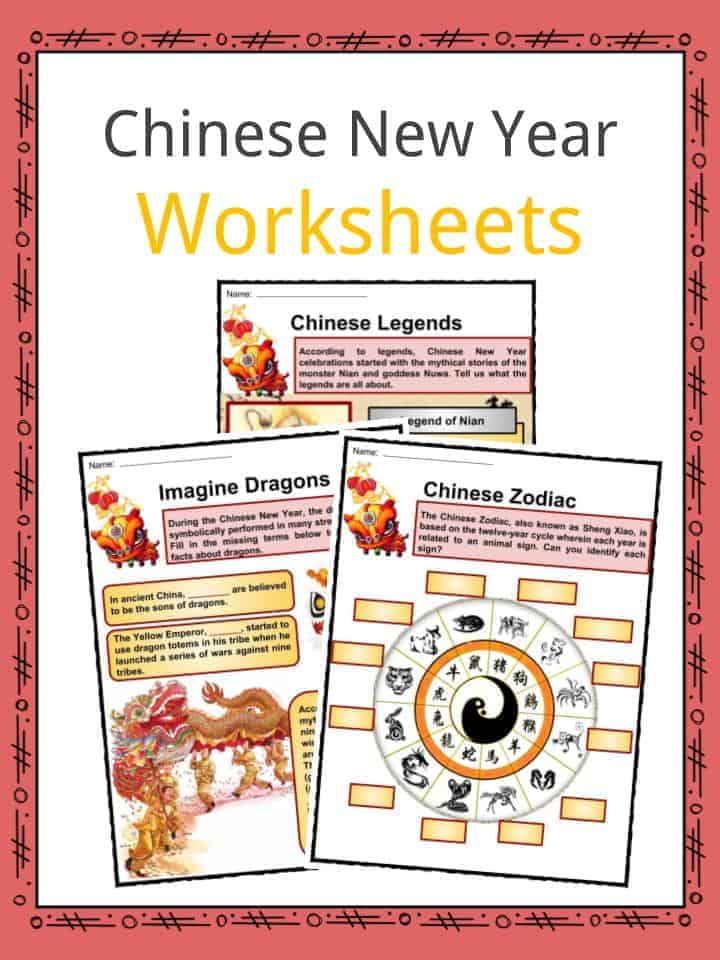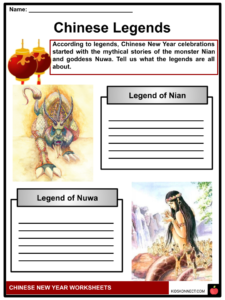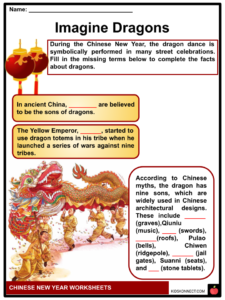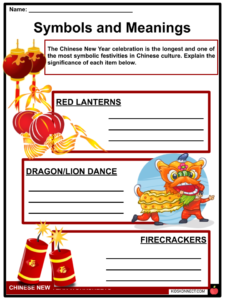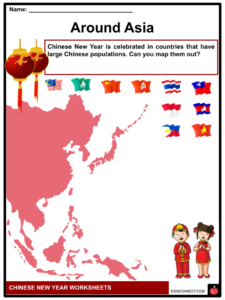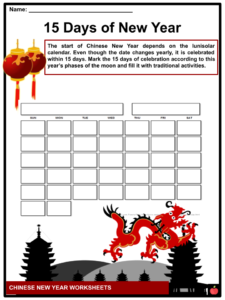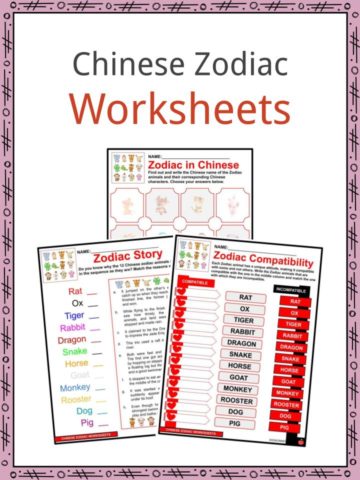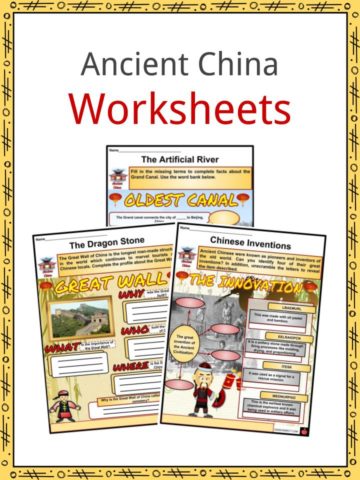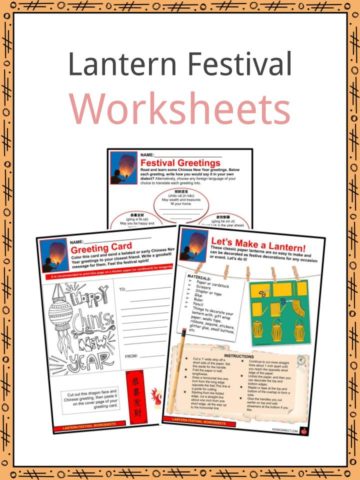Download This Sample
This sample is exclusively for KidsKonnect members!
To download this worksheet, click the button below to signup for free (it only takes a minute) and you'll be brought right back to this page to start the download!
Sign Me Up
Chinese New Year is celebrated at the turn of the lunisolar Chinese calendar. Also called the Spring Festival in Chinese culture, it is celebrated to mark the end of winter and the beginning of spring. Often intertwined with the Lunar New Year of at least 56 ethnic groups, the Chinese New Year is distinctly focused on ancient Chinese culture and traditions.
For more information read the fact file Chinese New Year below or download the comprehensive Chinese New Year worksheet pack, which includes 23 pages to utilize within the classroom or home environment.
Key Facts and Information
BACKGROUND OF NEW YEARS
- While there are different Lunar New Years celebrated in different cultures, including Vietnam, South Korea, Japan, Mongolia, Taiwan, Tibet, Singapore, Malaysia, and India, the Chinese New Year is a more specific celebration of this lunisolar calendar based festival celebrating the Chinese culture in and out of China.
- Since the Chinese New Year follows the lunisolar calendar, the annual date of celebration varies, unlike the western New Year that follows the Gregorian calendar is fixed every 1st of January.
- The Chinese New Year and Lunar New Year in East Asia typically fall around late January or early February.
- While most Lunar New Years of other cultures is celebrated on the first new moon following the winter solstice, Chinese New year is observed on the second new moon after the winter solstice.
- Because it marks the change to another season, the Chinese Lunar New Year is sometimes called Spring Festival.
- Like the ancient Chinese, other east Asian cultures, such as the Mongolians and Tibetan, have different interpretations and uses of the lunisolar calendar that explains the varying date of celebrating the Lunar New Year.
- Meanwhile, Japanese, Korean, and Vietnamese cultures have the same interpretation as the Chinese.
HISTORY OF THE CHINESE NEW YEAR
- The first mention of celebrating a new year in ancient China was in the book Simin Yueling written during the Han Dynasty.
- According to legends, Chinese New Year started with a mythical monster called Nian, who ate the villagers’ children. The villagers discovered that Nian was afraid of the color red and explosive noises. People used firecrackers, hung red lanterns, wore red clothes, and posted red scrolls on their doors and windows leading up to Chinese New Year. Nian was frightened and eventually captured by a monk.
- The calendar revolves around the cycle of 12 signs known as Chinese zodiac animals. Each new year manifests the attributes of one of the 12 zodiacs: Rat, ox, tiger, rabbit, dragon, snake, horse, goat, monkey, rooster, dog, and pig.
- In 1912, the Chinese adopted the Gregorian Calendar, which celebrates the New Year on the eve of December 31 to welcome January 1 as the first day of the year. However, China continues to celebrate the traditional Chinese New Year.
- The celebration lasts for fifteen days until the full moon. It’s also called the Spring Festival, for it usually falls during the first days of spring.
- Under Emperor Taizong of the Tang dynasty, the custom of sending bai nian tie or greeting cards for the new year began.
- During the Five Dynasties and Ten Kingdoms period, Spring Couplets or Chunlian were used to wish for a long-lasting spring. Couplets became common in house doors before the new year during the Song dynasty.
- When gunpowder was invented during the Tang dynasty, bamboo poles were filled with gunpowder and lit for louder explosions.
- Also, at the height of using firecrackers, giving money based on age or sui nian qian began during the Song dynasty.
- Under the Yuan dynasty, the Chinese people began to give nian gao, or year cakes, to their relatives. While the tradition of eating jiaozi or dumplings started during the Ming dynasty.
- The celebration revolves around traditional Chinese practices such as cleaning one’s house to honor the deities and ancestors, posting scrolls with lucky messages on windows and doors to get rid of bad spirits, and feasting.
- Today, many Chinese prefer the terms Lunar New Year or Spring Festival, while non-Chinese cultural backgrounds such as Indonesia and the Philippines, the term Chinese New Year is more commonly used.
COMMON TRADITIONS AND CELEBRATIONS
- On the eve of the celebration, each family will have dinner together around a family table. The meal usually consists of long noodles for a long life and fish for abundance. On the last day of the New Year, families eat round dumplings in the shape of a moon, which symbolizes a tight family unit.
- A comparable celebration with Thanksgiving and Christmas Eve dinner in the US.
- In northern China, jiaozi or dumplings shaped like a Chinese sycee symbolize wealth. While in the south, niangao, or the glutinous new year cake, is more popular.
- Other essential dishes served during the Chinese New Year include fish, spring rolls, sweet rice balls, good fortune fruit, and noodles.
- On the first day, fireworks, firecrackers, and bamboo sticks are lit to welcome the deities. In contrast, lion dances ward off bad spirits. It is also the typical time for family gatherings, especially for the senior members of families. Red packets are typically given to the younger generations and employees of companies. The Chinese believed that the number 8 brings prosperity versus to number 4, which means death. Red packets are typically enveloped with money.
- While many places in and out of China enjoy fireworks, cities such as Kowloon, Beijing, and Shanghai banned fireworks and other firecrackers due to fire hazard concerns. In Hong Kong and Singapore, government-authorized and sponsored fireworks displays are launched.
- On the second day, married daughters visit their birth parents and relatives. In Hong Kong, the deity Che Kung is worshipped in temples.
- Known as Chigou’s Day, the third day is observed with burning papers and staying at home.
- For Chinese people who celebrate the New Year for 15 days, the fourth day is reserved for business dinners or spring dinners.
- In northern China, people typically eat dumplings and re-open businesses on the 5th day. The 6th day is known as Horse’s Day, when people throw out garbage accumulated during the holiday, which means driving away the Ghost of Poverty.
- In Malaysia and Singapore, the 7th day is the day to avoid meat and eat raw fish salad for prosperity. On the 8th day, while everybody returns to work, employers or business owners typically host dinners for the birth of the Jade Emperor (also celebrated on the 9th and 10th days).
- The 15th day of the new year marks the Lantern Festival. The perfect day to eat rice dumplings and glutinous rice ball soup. Candles and lanterns are lit to guide good spirits home.
- While red packets, sweets, and food are given to relatives and friends, some gift items associated with bad luck and death are taboo. It includes handkerchiefs, chrysanthemums, clocks, knives, scissors, shoes, mirrors, and sandals.
- Kids also wear custom red clothes during the festival to scare away bad luck and spirits. Aside from wedded daughters, migrant Chinese workers travel home and attend family reunions at this time of the year.
- The common greeting includes Xin nian kauai le, Gong xi fa cai, and Gong hei fat choi.
- Red paper cutouts are used to decorate doors and windows. The traditional themes for the paper cutouts are happiness, longevity, wealth, and good fortune.
- Another tradition is the Chuen-Hop or Tray of Togetherness. The tray consists of eight varieties of food offered to guests. These foods include kumquats, peanuts, coconuts, and longan fruit.
- The flowers plum blossom and water narcissus are usually associated with Chinese New Year.
- Chinese New Year is also celebrated in countries that have a large Chinese population, including Southeast Asian countries of Malaysia, Singapore, Indonesia, Thailand, and the Philippines. In North America, Chinese populations in the US states of New York and California hold parades and programs. In Europe, celebrations can be observed in the cities of London, Paris, and Amsterdam. Meanwhile, Sydney, Australia, claimed to host the largest Chinese New Year celebration in its Chinatown outside of Asia.
- Chinese New Year in Malaysia is celebrated for two days as a public holiday, similar to Singapore, where street bazaar and lion dance competitions are held. In the Philippines, the Chinese New Year became a one-day public holiday in 2012. Many non-Chinese Filipinos visit Chinatown in Binondo, Manila, to participate in the celebrations.
Chinese New Year Worksheets
This fantastic bundle includes 23 ready-to-use Chinese New Year worksheets that are perfect for students to learn about Chinese New Year, which is celebrated at the turn of the lunisolar Chinese calendar. Also called the Spring Festival in Chinese culture, it is celebrated to mark the end of winter and the beginning of spring.
Worksheet Collection 1:
- Chinese New Year Facts
- Chinese Legends
- Imagine Dragons
- Chinese Zodiac
- Chuen-Hop
- Symbols and Meanings
- Chinese Traditions
- Around Asia
- 15 Days of New Year
- Lantern Design
- My New Year’s Resolution
Frequently Asked Questions
What is Chinese New Year?
Chinese New Year, also known as Spring Festival or Lunar New Year, is the most important traditional holiday in China. It marks the start of a new lunar year and the beginning of spring.
When is Chinese New Year celebrated?
Chinese New Year is celebrated at the turn of the lunar calendar, usually in late January or early February. The exact date of the holiday changes each year, as it is based on the lunar calendar.
How is Chinese New Year celebrated?
Chinese New Year is celebrated with a variety of traditional customs and activities. These include cleaning the house, decorating with red lanterns and banners, giving red envelopes filled with money as gifts, and preparing special foods. Families also gather for a big feast on New Year’s Eve.
What is the significance of the color red in Chinese New Year?
The color red is considered lucky in Chinese culture and is prominently featured during Chinese New Year. Red decorations, clothing, and envelopes are thought to bring good luck and ward off evil spirits.
How long does Chinese New Year last?
Chinese New Year typically lasts for 15 days. It ends with the Lantern Festival, which is celebrated on the 15th day of the new year.
Link/cite this page
If you reference any of the content on this page on your own website, please use the code below to cite this page as the original source.
Link will appear as Chinese New Year Facts & Worksheets: https://kidskonnect.com - KidsKonnect, January 27, 2024
Use With Any Curriculum
These worksheets have been specifically designed for use with any international curriculum. You can use these worksheets as-is, or edit them using Google Slides to make them more specific to your own student ability levels and curriculum standards.
